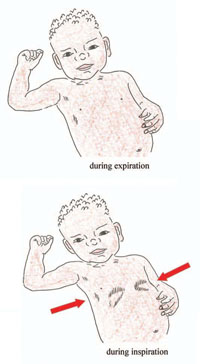
Children with pneumonia may have a range of clinical presentations, depending on their age and the cause of the pneumonia. Children who have bacterial pneumonia usually become severely ill and show the following symptoms:
Adults with pneumonia also have fever, cough, and fast or difficult breathing.
| If the child is aged: | The child has fast breathing if you count: |
|---|---|
| 2 months to 12 months old | 50 breaths or more per minute |
| 12 months to 5 years old | 40 breaths or more per minute |
In severe cases of pneumonia, children under five-years-old may struggle to breathe and usually show chest in-drawing, which you can observe as drawing inwards or retracting of the lower chest (red arrows in Figure 35.8) during inhalation (taking air into the lungs).

Pneumonia in children and adults is classified into non-severe and severe pneumonia based on the features of the condition summarised in Box 35.4. This classification is very important because it determines what treatment is given to the patient (as you will see in Section 35.4.4).
A child with fast breathing, chest in-drawing or stridor should be immediately referred to hospital.
Children
Adults
If a child with pneumonia has fast breathing (Table 35.2), but no general danger signs, or chest in-drawing, or stridor, classify him/her as having non-severe pneumonia. Adults with pneumonia who do not have the severe signs given in Box 35.4, are also classified as having non-severe pneumonia.